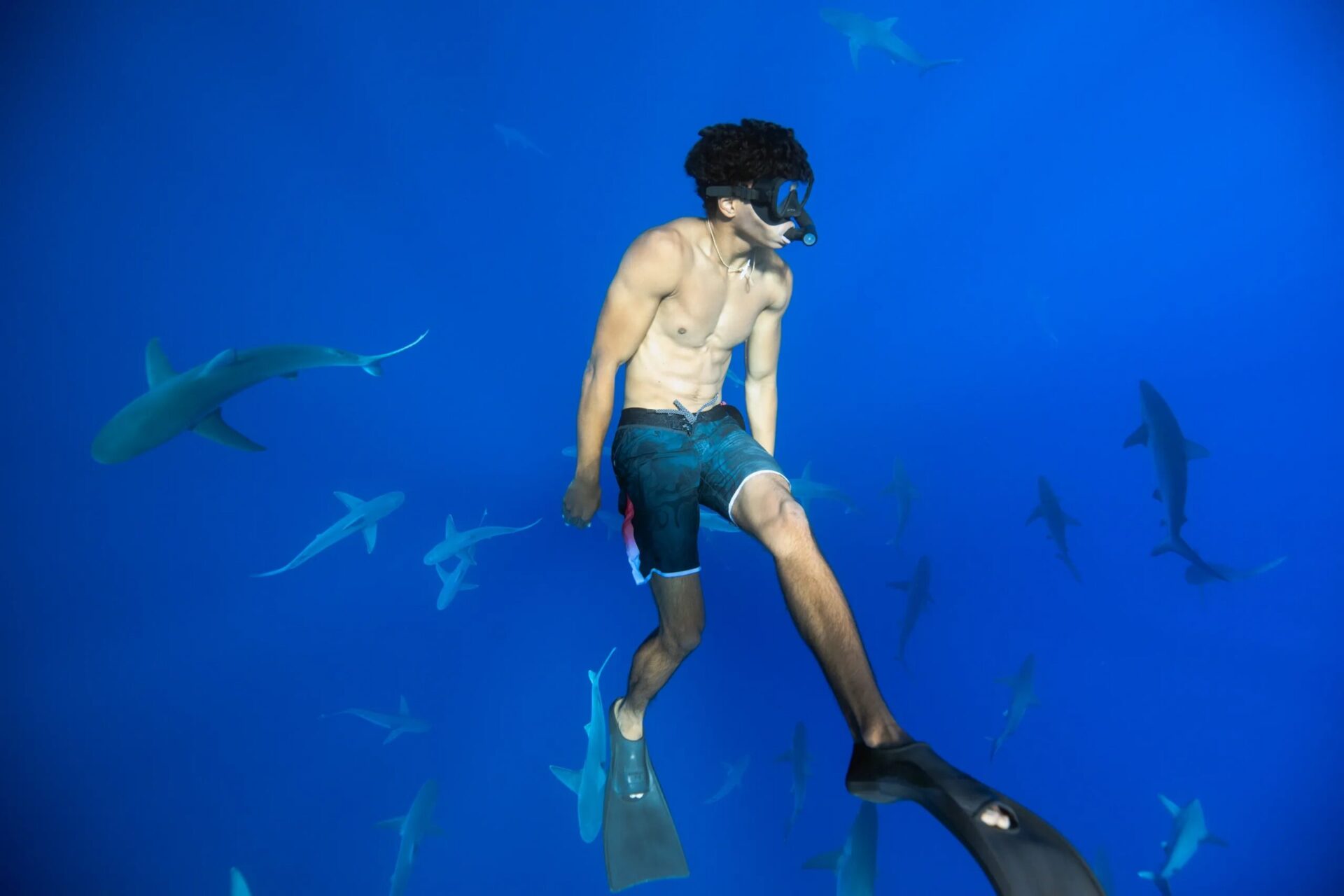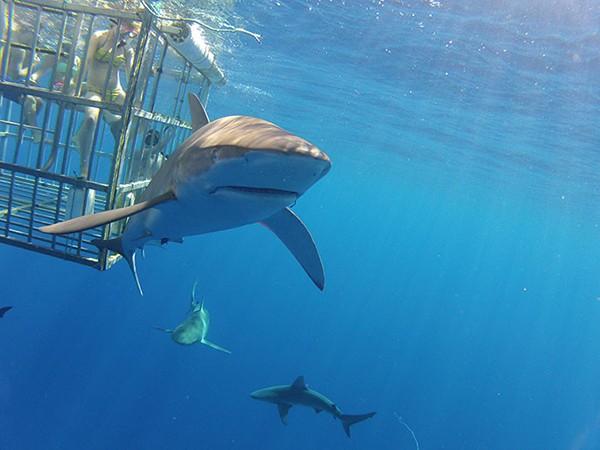Cue the “JAWS” music. People come to Hawai’i to enjoy a slice of paradise. Being a chain of islands means that if you’re visiting, chances are you’re going to spend some time in the ocean. Everyone who has spent any time in the water has had one word cross their mind at some point- “Shark”. Start thinking about that word too much and every splash, glint or glimmer becomes the creature of nightmares just below you, and your subsequent bee-line for shore could give Michael Phelps a run for his money. So what do you do to avoid a shark encounter? We here at Hawai’i Revealed have spent a lot of time in the water and now offer you, dear readers, the secret to avoid sharks: You can’t. But that doesn’t mean you need to worry. You don’t. The fact is sharks are always around and they are beautifully adapted to doing what they do, i.e. being sharks. Fortunately, humans aren’t a preferred food and attacks are extremely rare (and usually a case of mistaken identity). In fact, you are more likely to die by being killed in an aircraft crash, or to win an academy award, then being killed by a shark (so maybe you should prepare that acceptance speech before you go snorkeling). A shark’s best way to test whether they would like to eat something is by biting it. This helps to explain why so many attacks are just that, a bite and release rather than a shark actively looking to munch on people. According to the Florida Museum of Natural History, Florida still has the highest number of shark attacks compared to anyplace else in the world (219 between 2001 and 2014), with Australia following close behind (123 between 2001 and 2014), though Hawai’i is number 3 (72 during the same stretch of time). Quite the difference.
Shark attacks in Hawai’i have had more press lately due to an increased number occurring during 2013, on the island of Maui specifically. The culprit has been large tiger sharks, the most common dangerous shark to Hawaiian waters. No one knows what has caused the recent spike in attacks (pick any hot button issue and that is the most likely cause for that week). In response to public concern, the Pacific Islands Ocean Observing System with the Department of Land and Natural Resources (DLNR) and Division of Aquatic Resources (DAR) developed a program to learn more about these big, predatory fish and where they go. In late 2013 and early 2014, twenty-four large (average size around 12.3 feet) tiger sharks were tagged with satellite trackers on their dorsal fins. Since GPS signals don’t really work underwater, every time the shark’s fin breaks the surface, a point is taken. So as the sharks cruise around, a track is made that is laid over a map. This map show where these sharks go over time. The results can be seen on their website . It is important to remember that this is not done in real time, so you’re not seeing where the sharks are right at this moment. The data had to be gathered, processed, analyzed, cleaned up and then published so you can see it on the Google Earth map. The resulting information is fascinating regardless of how you feel about sharks. The fact is there are always sharks out there and in places that people regularly recreate. However if you look at the number of people in the water at any given time you can see just how rare an interaction is. For some adventure seekers (like us), diving with sharks is one of the most amazing experiences you can have and can bring a completely new level of respect for these magnificent animals. A number of dive companies throughout Hawai’i even offer tours that seek out sharky spots specifically for the chance to see these magnificent creatures in their natural habitat. Sharks have earned a bad reputation from movies and sensationalized news reports. Do they deserve it? Not really. They are not out to ruin anybody’s day only doing what they have always done. That being said there are a few things to remember that can help decrease your chances of having a bad encounter with a shark.
- Avoid swimming at night. Sharks mostly hunt at night, with the sunrise and sunset included. They can feel vibrations in the water and will often come to check out what is making all that noise.
- Avoid swimming in murky water. This includes near the mouth of rivers and drainages as well as after heavy rains. Sharks prefer to ambush their prey and murky water is some of the best cover. They actually have an special way to detect electromagnetic energy produced by living animals so they don’t have to see you to know you are there.
- Stay out of the water if you have any open wounds. They have an extraordinary ability to detect small amounts of blood from great distances (lemon sharks have been seen to detect up to 1 part per million).
- Avoid excessive splashing. A distressed meal is more appealing than a healthy one and again they are attracted by the vibrations in the water.
- If you see a shark, remain calm and slowly move away. The chances are the shark knows you are there and has already determined you are not a meal. Let the local lifeguards know.
- Use the buddy system. Always a good plan when going into the ocean anyway.
Shark Dives

One Ocean Diving: Shark Dive
For those who want to swim freely with sharks, One Ocean is an excellent experience. Expect a thrilling adventure with safety guidance from onboard naturalists. But you may want to be prepared for motion sickness in rough seas.
North Shore Shark Adventures: Shark Dive
For those seeking a thrilling adventure, North Shore Shark Adventures and Hawai‘i Shark Encounters offer shark cage diving tours off Hale‘iwa. You’ll watch sandbar and Galapagos sharks up close from a cage just above the water.
If you are lucky enough to get a chance to see one, enjoy the experience. Sharks are being hunted into extinction and there are no rules that protect them. They are an extremely valuable part of the ecosystem, helping to keep the ocean clean and prevent genetic diseases and weed out the injured and weak. In a way, it is comforting to know that sharks are cruising by us all the time yet not looking at us as a meal. Respect is important whenever you enter someone’s home and the ocean is home to sharks large and small. There’s an old joke that divers tell when asked by people if there are sharks in the water and it goes like this. Q: How can you tell if there are sharks in the water? A: Is it salty? If you are visiting Hawaii then you are more than likely going to swim in salty water. And if you do then there is a good chance that somewhere close by is a shark or two. Don’t be afraid, be cautious. The chances are good that you will never even see one. But you can be sure that they are out there and most likely doing their best to avoid you too. If your still worried about the possibility of being bitten keep your eye to the sky to because you’ve got a better chance of seeing a plane heading straight in your direction. Now, who’s ready?

Andrew Doughty is the famous author of the widely popular Hawaii Revealed series including Kauai Revealed, Oahu Revealed, Maui Revealed and the Big Island Revealed. He moved to Kauai many years ago after he fell in love with the beauty of the islands and decided to never go back. He is known for his candid opinion on each of Hawaii’s attractions, be it a restaurant, a helicopter ride, a beach or a resort. For the last two decades, he has managed to keep his identity anonymous so that his reviews can remain unbiased and only be influenced by his own opinions and thoughts. You can learn more about his beautiful journey at this link – About the author





0 Comments